Iwakuni
last update: February 23, 2022
Iwakuni (岩国) is a small town of about 150,000 inhabitants in the southeast of Yamaguchi prefecture, famous for its iconic and unique Kintai-kyo bridge, featuring five sinuous wooden arches. Since 1952 it has housed a large US military base which has created quite a few tensions with the locals over the years. It is one of the most popular day trips among those staying in Hiroshima, just 40 km away.
Things to do and things to see in Iwakuni
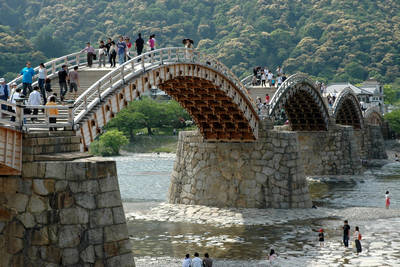
Kintai-kyo Bridge
The Kintaikyo bridge is the most famous landmark of the town of Iwakuni and already in ancient times its fame spread throughout the country. It is an elegant bridge made up of five sinuous wooden arches resting on massive stone pillars over the Nishiki River. The bridge was completed in 1673 and survived until 1950, when Iwakuni was hit by a violent typhoon that severely damaged the bridge. Shortly thereafter, the sad but determined residents began to rebuild the bridge exactly as it was, and completed it in 1953. Originally this bridge could only be crossed by samurai, while today it can be crossed by anyone, but to do so you have to pay a fee of 310¥ which includes two crossings, one in each direction. The bridge is always open, and after the closing time of the ticket office, visitors are trusted to put the money in a dedicated box. A combined ticket (970¥) includes the passage over the Kintaikyo Bridge, the use of the cable car to both ascend and descend Mount Shiroyama and the entrance to the castle.
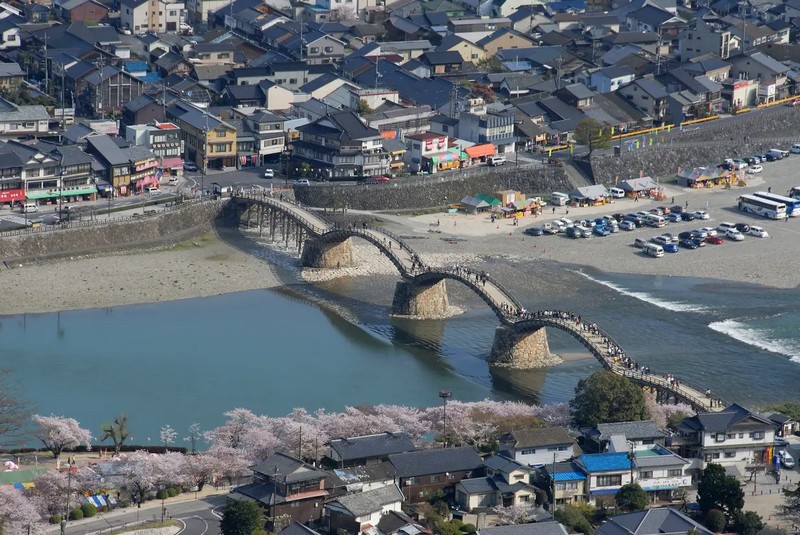
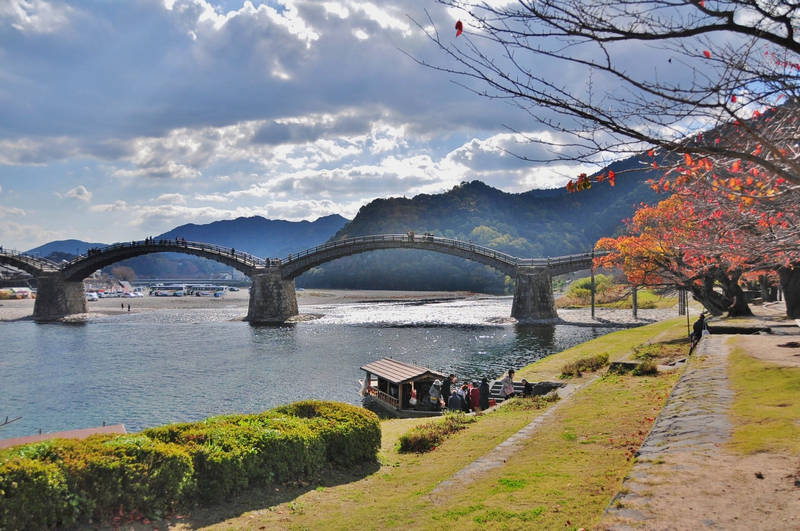
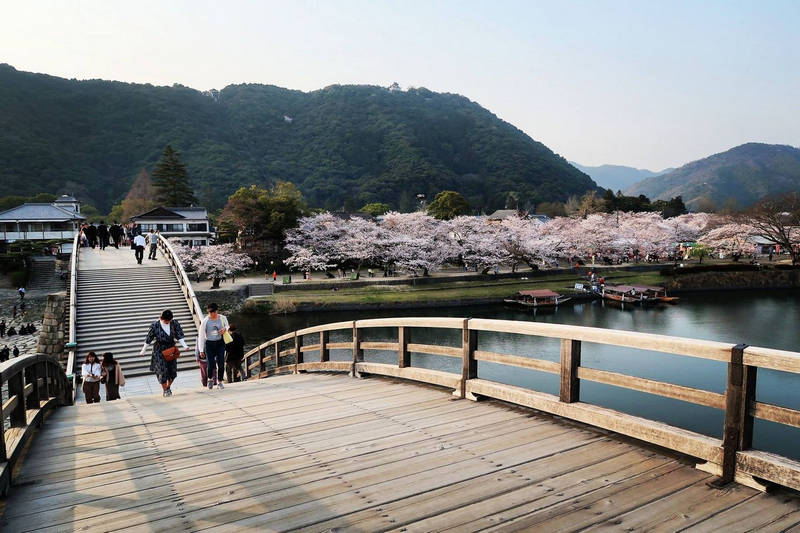
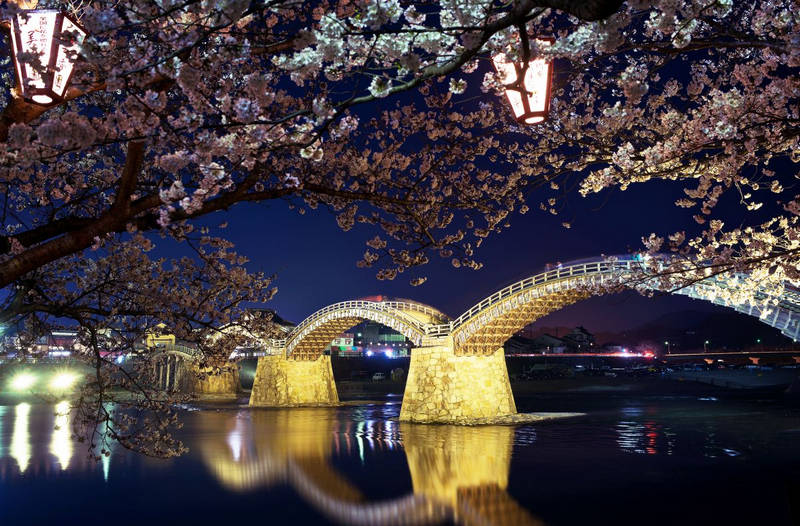
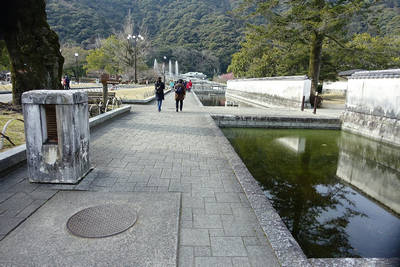
Kikko Park
Kikko Park is a pleasant garden on the north bank of the bridge, popular between late March and early April for cherry blossoms, but many other floral species bloom during the spring and color the park with joy. In front of the entrance you will find a statue of Hiroyoshi Kikkawa, the feudal lord who directed the construction of the Kintaikyo. The north-west side of the park is bordered by a canal, which is also full of flowers. During the Edo period the residences of the local ruling family were located in this area, so don't be surprised to find several former samurai residences and museums related to Feudal Age Iwakuni in the area, in particular:
- The Choko-kan (free entrance, 9-17, closed on monday), a historical library with documents and paintings on parchment, sometimes also called Iwakuni Antiquities Museum.
- The Kikkawa Museum (free entranec, 9-17, closed on monday), a small museum that preserves the possessions of the Kikkawa family, in particular many ancient weapons.
- The Mekata Residence (fre entrance, 9:30-16:30, closed on monday), a house once belonging to the Mekata, a middle-aristocratic samurai family.
- The White Snake Museum (200¥, 9-17), which has nothing to do with samurai but still deserves to be mentioned. As the name suggests, it is a museum dedicated to white snakes (shirohebi) of the Iwakuni area. In the Shinto tradition, meeting one of these snakes is a good omen, as these snakes are the messengers of Benten, the Japanese goddess of wealth.
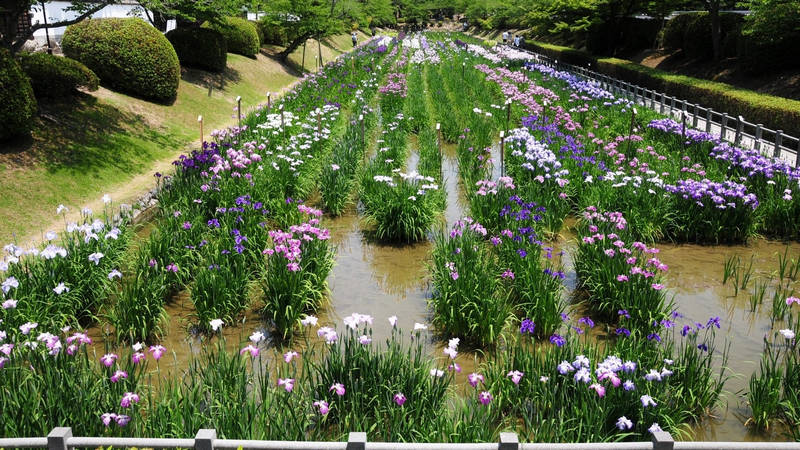 an iris garden along the moat surrounding Kikko Park
an iris garden along the moat surrounding Kikko Park
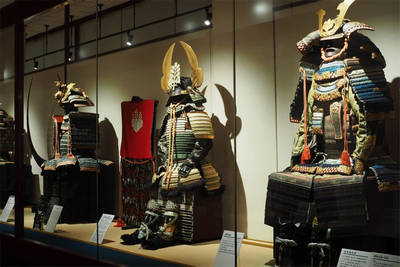
Iwakuni Art Museum
(admission 800¥, opening hours 9-17)
A small museum that preserves and exhibits a whole series of objects that belonged to the feudal lords of Iwakuni, and in particular a large collection of swords. But not only that, also armor and furnishings of the ancient residences.
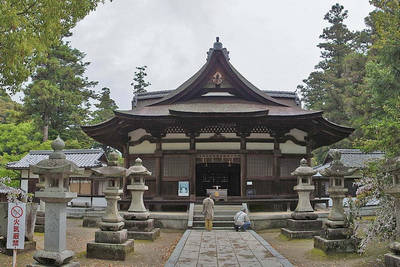
Kikko Shrine
(free admission, opening hours 7-17)
The family shrine of the mighty Kikkawa samurai of Iwakuni, built in 1884. The shrine features several smaller buildings and shrines, in an area surrounded by a water-filled moat and with Mount Shiroyama behind it.
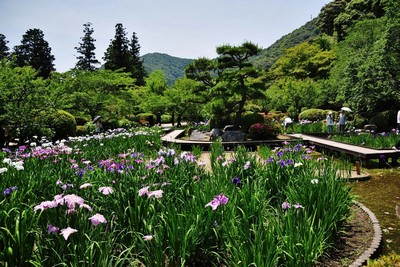
Shiroyama Iris Garden
A small and adorable traditional garden with many small canals, ponds and wooden bridges, where you can admire the iris flowers, which bloom in June. It is located next to the Kikko Shrine.
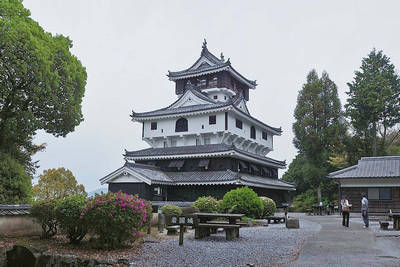
Iwakuni Castle
(admission 270¥, opening hours 9:00-16:45)
Iwakuni Castle was originally built at the behest of Kikkawa Hiroie, between 1601 and 1608. The location was incredibly strategic at the time, on top of Mount Shiroyama about 200 meters high and surrounded by half from the natural moat formed by the Nishiki River. However, this castle did not last long, as it was demolished by decree of the shogun just seven years after its completion. In 1962 it was decided to rebuild the keep of the castle, in ferrocement, based on some original drawings of the ancient castle which survived only seven years. Inside there are swords, armor and other objects related to the history of the castle and the Kintaikyo bridge. The view from the top of the castle, which has four floors, is very nice. Getting to the castle on foot requires a long 30-40 minute climb up Mount Shiroyama. Alternatively, most visitors use a cable car opened in the 1990s (560¥ for a return ticket). The lower station of the cable car is located behind Kikko Park, while the castle is another five-minute walk from the upper station. A combined ticket (970¥) includes the use of the cable car to both go up and down Mount Shiroyama, the entrance to the castle and the passage over the Kintaikyo bridge.
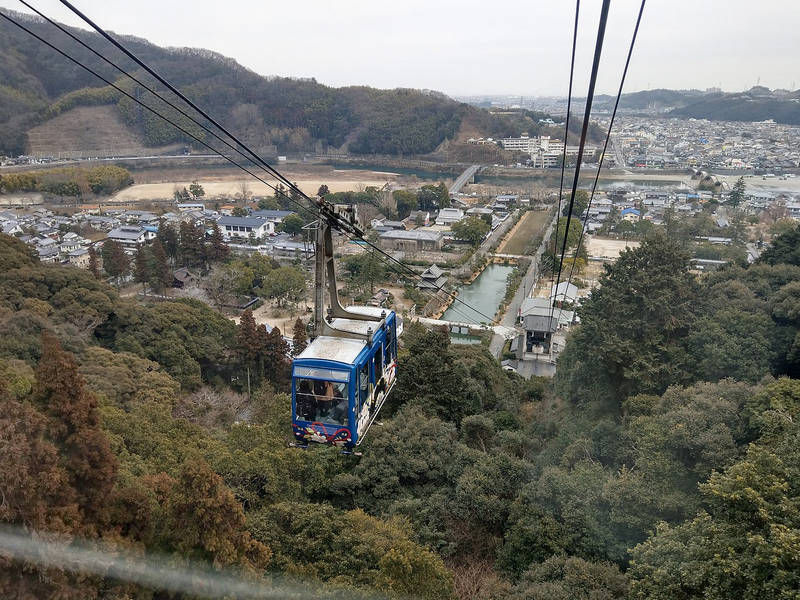 the cable car to Mount Shiroyama
the cable car to Mount Shiroyama
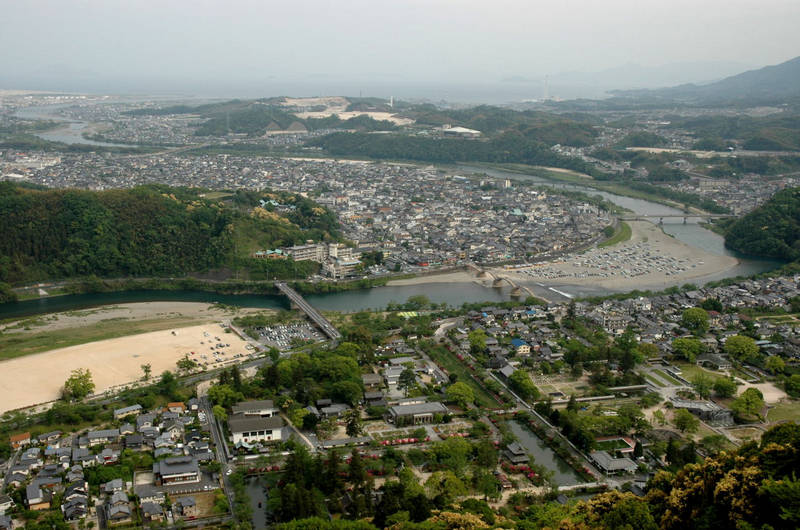 view from the top of the castle (credits)
view from the top of the castle (credits)
Where to stay in Iwakuni
Iwakuni is a small town, mainly a hit and run tourism destination, with most visitors leaving the city early in the evening to return to Hiroshima or continue their journey to other destinations. There aren't a lot of hotels. If you need a hotel near Iwakuni Station, you can take a look at the
Green Rich Hotel Iwakuni Ekimae (a mid-range business hotel with excellent public baths to relax in), or at the
Hotel Trend Iwakuni (simple low cost hotel). If, on the other hand, you want to spend a magical night in Iwakuni, and enjoy the empty and silent city when almost all the tourists have left, you can take a look at the magnificent
Iwakuni Kokusai Kanko Hotel in front of the river.
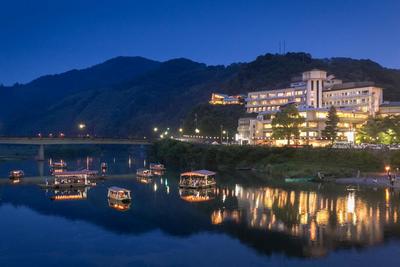 A large hotel of a very high standard overlooking the river and the Kintaikyo Bridge, offering both Western-style rooms and Japanese-style rooms with tatami mats and futons. A magical place to relax thanks to the wonderful onsen area, with several indoor and outdoor thermal pools, some of which have a panoramic view of the river, and saunas. Inside, several restaurants offer a wide range of choices for lunch or dinner. Superb buffet breakfast. A hotel of this standard in other popular areas of Japan would cost at least twice as much.
Price range: single rooms 9,000-12,000¥, double rooms 12,000-25,000¥.
A large hotel of a very high standard overlooking the river and the Kintaikyo Bridge, offering both Western-style rooms and Japanese-style rooms with tatami mats and futons. A magical place to relax thanks to the wonderful onsen area, with several indoor and outdoor thermal pools, some of which have a panoramic view of the river, and saunas. Inside, several restaurants offer a wide range of choices for lunch or dinner. Superb buffet breakfast. A hotel of this standard in other popular areas of Japan would cost at least twice as much.
Price range: single rooms 9,000-12,000¥, double rooms 12,000-25,000¥.
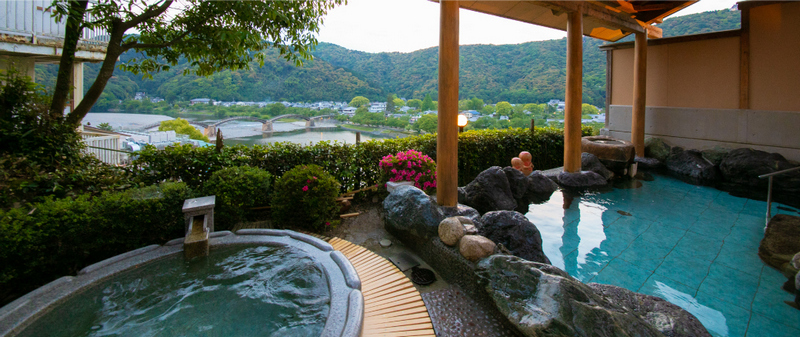 one of the outdoor onsen of the Kokusai Kanko Hotel
one of the outdoor onsen of the Kokusai Kanko Hotel
Eating in Iwakuni, cafes and restaurants
Iwakuni has no noteworthy culinary traditions. In the area of the Kintai-kyo bridge you will find several restaurants and cafes for tourists who visit the city daily. We recommend the
Shiroyama Cafe for a quick curry rice lunch or pie. Be careful because almost everything closes by 16-17. To find something open in the city to eat after this time, you will have to go to the Iwakuni station area.
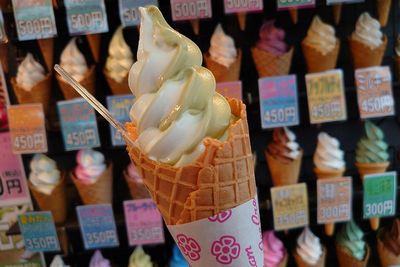
Ice cream with extravagant tastes
If, on the other hand, you want to try something curious, immediately after crossing the bridge, on the left, you will find two crazy ice cream shops,
Shokujidokoro Musashi and
Sasakiya Kojiro Shoten. These two ice cream shops compete with each other to offer the widest choice of ice cream flavors (Shokujidokoro Musashi boasts of having over 190 flavors available), and also to offer the most unusual ice cream flavors. In addition to the classics, here you will find dozens of absurd flavors, such as ramen ice cream, garlic ice cream, or habanero pepper ice cream.
How to get to Iwakuni
The easiest way to visit Iwakuni is with a day trip from Hiroshima, which is well connected to Iwakuni by both high-speed shinkansen trains and local lines. Iwakuni has two main railway stations,
Iwakuni Station served by local trains and located in the city center, and
Shin-Iwakuni Station where shinkansen trains stop and located outside the center.
If you have a Japan Rail Pass or don't want to spare any expense, you can take the
JR Sanyo Shinkansen to Shin-Iwakuni, but be careful as only Kodama trains stop at this station. The journey takes just 15 minutes and costs 1640¥ for a non-reserved seat or 3000¥ for a reserved seat.
Alternatively, Iwakuni Station can be reached via the local
JR Sanyo Main Line. In this case the journey takes about 50 minutes and costs 770¥, while
Miyajima station is approximately halfway and therefore just 25 minutes away from Iwakuni.
However, neither Iwakuni station nor Shin-Iwakuni station are close to the famous bridge, castle and other tourist attractions of the city (all located very close to each other). Whether you arrive in the city by local train, or you arrive by shinkansen, unless you take very long walks (about 5 km from both stations), you will have to take a taxi or a bus.
From Iwakuni Station, you will find buses departing every 10-15 minutes to the Kintai-kyo bridge area (300¥). There are far fewer buses from Shin-Iwakuni Station, one every 30-60 minutes (350¥). Finally, it may be useful to know that the two stations of Iwakuni and Shin-Iwakuni are connected to each other by a railway line called
Nishikigawa Seiryū Line (15 minutes, 420¥).
Map of Iwakuni
Guided tours, activities and other things to do
If you are planning a trip to Japan and you want to do something more than just visiting famous places and monuments, we suggest you to use
Rakuten Travel Experiences.
How to use Rakuten Travel Experiences
Rakuten Travel is a very useful website to
enrich your travel experience, especially if you are going solo or it's your first time in Japan.
Because of the language barrier (and more), in Japan it is very difficult to interact with the locals and to get off the tourist track.
Thanks to Rakuten Travel you can find a lot of interesting and sometimes unique
guided tours and activities all over Japan (and not only in Japan), that you would otherwise never be able to enjoy.
But there's more: on Rakuten Travel you can also
buy tickets for several famous attractions, events, transportation and other useful services for tourists. Last but not least, you can
reserve a table in hundreds of restaurants.
Some examples
Take a look at Rakuten Travel Experiences
You may also be interested in






 view from the top of the castle (credits)
view from the top of the castle (credits)
 A large hotel of a very high standard overlooking the river and the Kintaikyo Bridge, offering both Western-style rooms and Japanese-style rooms with tatami mats and futons. A magical place to relax thanks to the wonderful onsen area, with several indoor and outdoor thermal pools, some of which have a panoramic view of the river, and saunas. Inside, several restaurants offer a wide range of choices for lunch or dinner. Superb buffet breakfast. A hotel of this standard in other popular areas of Japan would cost at least twice as much.
Price range: single rooms 9,000-12,000¥, double rooms 12,000-25,000¥.
A large hotel of a very high standard overlooking the river and the Kintaikyo Bridge, offering both Western-style rooms and Japanese-style rooms with tatami mats and futons. A magical place to relax thanks to the wonderful onsen area, with several indoor and outdoor thermal pools, some of which have a panoramic view of the river, and saunas. Inside, several restaurants offer a wide range of choices for lunch or dinner. Superb buffet breakfast. A hotel of this standard in other popular areas of Japan would cost at least twice as much.
Price range: single rooms 9,000-12,000¥, double rooms 12,000-25,000¥.
